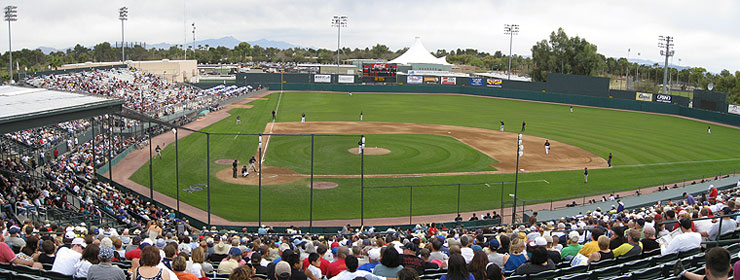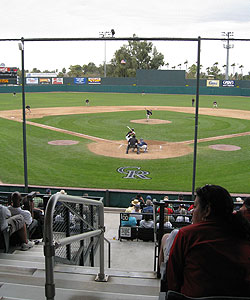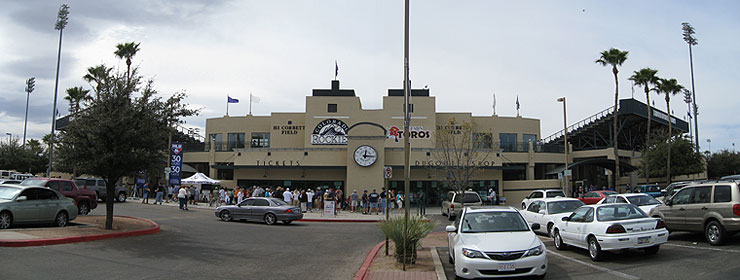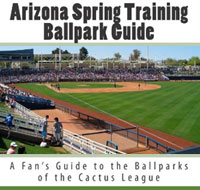
|
When it comes to spring training ballparks, Hi Corbett Field is the granddaddy of those still standing.
Built in 1937 - ten years before the first Cactus League game was ever played - Hi Corbett Field is a reminder of what ballparks used to be. And that was simply a place to watch a baseball game. So if it's modern amenities you seek, you've come the wrong place. Thereís no berm to stretch out on or suites to entertain clients in. Heck, there arenít even seats directly behind the dugout. A kids zone to distract young fans would feel out of place, not that there's room for one. The entertainment is confined to the playing field, which is as angular as the grandstands that surround it. In total, those grandstands contain more aluminum bleachers than they do plastic chairs. All but a handful of those seats are above the interior concourse, so most fans walk up stairs to get to their seats. Sections vary in size and height, ranging from just 12 rows of seats in the original grandstand behind home plate to 33 rows in the east (right field) pavilion. For many years a small section of bleachers was set up on the patio well down the left field line. Called the Sandpile in honor of Hi Corbettís spring training tenant since 1993, the Colorado Rockies, the seats there were the cheapest to be found anywhere in the Cactus League and were a take-off on the Rockpile section found at Coors Field. In 2009 the patio was cleared of bleachers and replaced with two dozen umbrella covered picnic tables. The Sandpile still exists but is now a part of the grandstand, officially occupying the final section of the west pavilion in left field. To say the least, the fieldís dimensions are quixotic. Advertising billboards are behind the outfield fence, not plastered to it, and the dark green walls that serve as the field's furthest boundaries range in depth from 349' in right field to 410' in left-center. The center field wall juts inward so that it's just 392' from home plate, yet a ball must travel 366' to clear the fence in left.
A net attached to the backstop extends to a small roof that is affixed to the press box. The net does a better job at protecting fans from foul balls than the roof does shielding them from the sun, as Hi Corbett is a notorious sun field. Thatís because it was built facing the sun, a practice long ago discontinued because of the visibility problems it creates for hitters. The roof eases the burden on the eyes of fans in the two sections (J, K) covered by it, but canít completely block out every ray due to the sunís angle. Shade is scarce in the stands but views of the surrounding mountain ranges are not. The peaks of the nearby Rincon and Santa Rita Mountains can be seen from all but the field level box seats. Fans sitting in the upper portions of seating sections down either baseline can see the practice fields used by the Rockies beyond right field. The Edith Ball Aquatics Center is behind left field and its uniquely shaped 80í tall tensile structure roof is visible regardless of where fans sit. A pair of mesquite trees reside on ballpark grounds down the right field line in a fenced off grassy area where friends and families of Rockies players can watch the game in privacy. All games begin with the classic 1960 jingle "It's A Beautiful Day For A Ballgame" by the Harry Simeone Songsters. Just as is done in Denver, "Rocky Mountain Way" is played following a Rockies victory. The scoreboard in left-center field has one feature no other in the Cactus League does Ė a panel that shows the temperature. A message board is in right-center, but it wasnít operational during spring training in 2009. As bland as it looks on the inside, Hi Corbett Field sports an attractive beige stucco exterior that has the logos of the Rockies and Tucson Toros prominently displayed on it. A small clock tower bisects the ticket office and team store. All were built in 1999, the last time the park received a major renovation. Two displays inside of Hi Corbett Field alert fans to the history that has occurred there. Mementos of the Tucson Toros are on permanent display behind glass. The Toros were the cityís Triple-A club and the ballparkís summer tenant from 1969-1997. They will finally return to their origins in 2009, albeit as members of the independent Golden Baseball League. Across the concourse from the Toros display, the Hi Corbett Field Wall of Fame alphabetically lists each of the 74 members of Baseball's Hall of Fame that the ballpark has hosted over the years. The list, which begins with Hank Aaron and ends with Robin Yount, is contained within a simple wood case thatís attached to the wall behind home plate. Basic in design, itís impressive in impact. That statement can also apply to the ballpark itself. In a sport so steeped in history, but with its playgrounds becoming less so, ballparks built in an era more than a decade older than the current generation of players are increasingly rare. So while antiquated and even outdated are often used to describe Hi Corbett Field, perhaps authentic and historic sum it up best.
Location and ParkingMuch of Hi Corbett Fieldís charm comes from its location, which is in a city park, an idyllic setting for spring training if there ever was one. The ballpark is just one of many diversions for Tucsonans in the 131-acre Gene C. Reid Park. Included in the mix are two public golf courses and a zoo. The fairways of the Reid Park Golf Course run parallel to the left field line, while over 500 animals live in the Reid Park Zoo. An aquatics center, outdoor stage for concerts and plays, dog park, youth fields and picnic areas also reside in Reid Park, which is bordered by single story homes on its eastern side, where the ballpark is located. Being in a city park makes the scenery surrounding the stadium possible, as numerous trees are able to thrive thanks to irrigation that is typically not available at other ballparks within the Sonoran Desert region, which encompasses Tucson and Phoenix. Parking at the ballpark is free, but limited. The paved lot fills up fast because of its small size, but more free parking is available nearby at the El Con Mall, a half-mile north of Hi Corbett. Shuttle service is available from the northeast corner of the mall. The shuttles are operated by the cityís Sun Tran system and operate continuously beginning two hours before first pitch. Fans are dropped off and later picked up on East Camino Campestre, just a few paces from the edge of the ballparkís parking lot.
Ballpark HistoryIn 1937, just 25 years after Arizona gained statehood, the city of Tucson built a baseball park in what was still a generally undeveloped desert town. The Tucson Lizards, an entry in the low-level Class D Arizona-Texas League, were the first team to call Randolph Municipal Baseball Park home. That was the official name of the ballpark on March 8, 1947 when 4,934 fans showed up to watch the Cleveland Indians play the New York Giants. Those who were there that day not only saw the Indians win 3-1, they also witnessed the inaugural game in the history of the Cactus League. The Indians played a half dozen more games at Randolph Park that spring. The total attendance for all seven was 15,600.
As baseball grew in popularity over the years so too did the capacity of Hi Corbett Field through a series of stadium improvements. By May 17, 1981 it was big enough to host a crowd of 12,863 for a game between Tucson's Triple-A team, the Toros, and Salt Lake City. The Toros called Hi Corbett Field home from 1969 to 1997. After 46 spring trainings in Tucson, the Indians announced in 1992 they were leaving Arizona for a new complex that was being built in Homestead, Florida. The team never did move to Homestead, as their complex there was wiped out in August of that year by Hurricane Andrew. The Indians instead wound up in Winter Haven. They couldn't return to Tucson, as by then the expansion Colorado Rockies had agreed to a 4-year lease to train there. In order to bring the Rockies to town the city agreed to renovate Hi Corbett Field in 1992, the first of three renovations it underwent in the 1990s. In 1997 new seats were installed and the clubhouse expanded. The 1999 renovation added a new ticket office and dugout shop to the front of the stadium. The Rockies' original lease was a short-term one as the team did not intend to stay in Tucson unless the city could attract another team to train in the area. Thanks to the building of Tucson Electric Park the city was able to lure two teams to town and the Rockies signed a 15-year lease in 1997 to stay in Tucson, where the Arizona Diamondbacks and Chicago White Sox joined them in 1998. Although Tucson Electric Park ensured the stability of spring training in Tucson, it cost Hi Corbett Field its beloved minor league baseball team. The Toros were replaced in the Pacific Coast League in 1998 by the Sidewinders, who promptly moved to Tucson's new ballpark, which is less than 5 miles from Hi Corbett. In 2008 the Sidewinders ended their eleven year tenure across town, bolting for a newer ballpark in a new state (Nevada). That enabled the Toros to be resurrected, beginning in 2009 when they return to Hi Corbett Field as members of an independent league. The Sidewinders weren't the only tenant Tucson Electric Park lost in 2008, as the White Sox bought out the remaining years of their lease so they could move their spring training operations to Glendale. While the move of the Sidewinders enabled the Toros to return to Hi Corbett, the loss of the White Sox could very likely have dire consequences at the birthplace of the Cactus League. That's because the Rockies have an out-clause in their lease, which expires in 2011, that enables them to terminate it if fewer than three teams train in Tucson, which is now the case as only the Diamondbacks remain at Tucson Electric Park. In order for either team to stay, another team (and probably two) would have to relocate to Tucson or a nearby city, such as Marana. But that scenario is unlikely to happen, as teams now prefer to train in close proximity to each other in Phoenix, a two-hour bus ride and 100 miles to the north. The Rockies are known to be looking in that direction. Ditto for the Diamondbacks. So after six decades, Hi Corbett Field is likely entering the bottom of the ninth inning in its days as a spring training venue.

Hi Corbett Field Footnotes
| ||||||||||||||||||||||||||


 The general quirky character of the place is enhanced by the angular backstop, which extends between the dugouts and is held up by visible supports.
The general quirky character of the place is enhanced by the angular backstop, which extends between the dugouts and is held up by visible supports.


